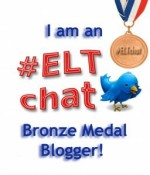
Photo Credit: Diego Cupolo via Compfight cc
The inspiration for the recent #eltchat on lesson planning came largely from @michaelegriffin’s post 29 statements about lesson plans. It seems that people have strong views about lesson planning, with some advocating a pure ‘jungle path’ approach (to use Jim Scrivener’s term) and others seeing benefits in planning, though not necessarily in following a plan rigidly.
The chat (05/06/13) started with two main questions posed by @shaunwilden: Is planning the same as preparedness and do we need to plan at all?
Is planning the same as preparedness?
This thread was referring to a recent talk by Underhill and Maley at IATEFL
The summary of the talk: Teacher training has tended to focus on technical preparation, yet teachers often find themselves unprepared for the human unpredictability of real lessons. This workshop aims to open up discussion on the moment-by-moment improvisation which is at the heart of teaching, and to suggest ways of developing ‘preparedness’ for the unpredictable.
@teflerinha suggested that both preparation and preparedness were important, and @efl101 wondered if planning became preparedness with experience, and similarly @josayers commented that ‘planning some lessons moves us towards being more prepared for all lessons.’
Is planning something newer teachers need to do more than experienced teachers?
There was certainly something of a consensus that newer teachers needed to spend longer planning. For example @ OUPELTGlobal ‘When I was starting my career planning helped. With experience, I needed less planning.’
However, several people also felt that getting trainee teachers to plan in detail could be counter-productive. @harrisonmike commented ‘over planning can make you less prepared ‘it isn’t going as I planned PANIC’’ and that it was a problem that ‘minute by minute planning is indoctrinated in ITT.’ @Shaunwilden agreed that ‘training courses make teachers overplan to be honest ‘ and that ‘overplanning makes one less prepared and less flexible.’
On the other hand, @teflerinha pointed out that ‘planning in ITT serves a different function than planning in real life.’ ‘planning makes you think things through.’ And @shaunwilden added ‘It’s a way of showing a trainee can analyse language, has taken on board input etc.’ And @teflerinha again ‘To get teachers/trainees to think about why they are planning each stage and how it relates to the whole- and for observers to see that thinking.’
Many people felt it was a process novice teachers had to go through. For example, @OUPELTGlobal said ‘Yes, have to admit that all the planning I did helped in later years, but it didn’t feel great at the time.’ And @pjgallantry ‘you’ve got to know the ‘rules’ of a lesson, before you can bend/break them – hence why Lesson planning is important for new Ts..’
There was also a brief discussion about the value of scripting instructions. It was agreed that this can easily be taken too far (@efl101 had seen 5 hour lesson plan completely scripted), but that it could be useful for inexperienced teachers with lower levels (@harrisonmike)
@hartle said, as a very experienced teacher, ‘My plans maybe 5 lines, but still there, as a basis.’
Does writing a plan mean you have to follow it?
@jo_cummins: said ‘I always make a lesson plan. I don’t always follow it. I often don’t even look at it.’ This seemed to be an important point, that it might be the process of writing the lesson plan that was important, rather than having it as a crutch in the lesson, which might well end up going in a very different direction, in response to the students.
@shaunwilden gave an example of how aims and objectives might change, ‘e.g.you started thinking you were going to introduce language, and then on planning realise it’s more review.’
@OUPELTGlobal asked ‘@OUPELTGlobal: Does planning inhibit sts from “interrupting” the teacher? going off the plan?’
And @jo_sayers made the point that ‘predicting actual learning is much harder than we think and we are often wildly optimistic.’
@teflerinha responded ‘Totally agree, but still useful to have an idea what we’d like to achieve, and then be flexible..’
@pjgallantry added ‘you always have to factor in ‘Factor X’ into a LP – anything from Ss being unhappy over st to teacher having a screaming headache’
@TeacherAlan1 raised an important point, asking ‘Is anyone required to show their lesson plans to admin? Or require your teachers to show them to you? This might easily influence how much teachers feel they have to follow their plans.
But @michaelegriffin made the point ‘My current thought is that lesson plans only get in the way if we let them. Ss don’t feel blocked unless T blocks.’
Can students tell (or do they care) if you have a lesson plan?
@colm_smyth ‘I guess students can tell by structure of teacher’s board work, teacher’s composure and activity transition’
@michaelegriffin ‘I think teachers sense if a teacher is prepared and that may be based on having a lesson plan’
@rliberni ‘Do ss know when things are unplanned (as opposed to unstructured)? I think they probably do’
What about planning a series of lessons?
@teflerinha commented ‘What I really DON’T like is planning a series of lessons in advance, or using last year’s because can’t respond 2 what happens’
@oupeltglobal replied ‘I agree with that. Teacher should react to the students they have – different sts & different plans’
And @cioccas ‘Can’t plan far in advance when you’re constantly changing to meet changing needs in the class.’
Post lesson planning
@efl101 asked ‘how often do you analyse/review plan after lesson 2 compare what actually happened and why and what u can learn etc?
@shaunwilden answered: ‘I did in my first few years as a teacher but then sort of fell out of the habit of noting it down’ and @hartle ‘when I 1st started teaching I did a lot. Now, I analyse what happens in class more, interactions between stds, successes.’
@efl101 responded ‘same but think it would be interesting to see if there are patterns etc. but time often prevents proper reflection’
And a great point to conclude from @mstrep: ‘Good planning makes a good teacher. Ability to improvise and adaptability make a great one’.
Other useful links
@pjgallantry shared a great visual representation of all the factors which contribute to teacher’s input, students’ input and output.
He also referred to The Secret DOS ‘s excellent recent post on lesson planning, The map is not the territory, which I won’t summarise here, but which is well worth reading.
@muranava referred us to this post by Willy Cardoso
Another relevant post is Steve Brown’s A case for anti-planning.
Dale Coulter’s post on lesson skeletons and retrospective planning
Scott Thornbury and other luminaries on the IDTI blog on How important is lesson planning?
And (if I may) my post ‘What’s the point of planning?’
Finally, @michaelegriffin gave us this link to Tessa Woodward’s book on planning lessons and courses, which he says ‘I did not enjoyed this book the first 3 times I looked at it but now love it’

















